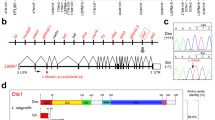Summary
The genetics of body asymmetry inLymnaea peregra follows a maternal mode of inheritance involving a single locus with dextrality being dominant to sinistrality. Maternal inheritance implies that all members of a brood have the same phenotype, however, some broods contain a few individuals of opposite coil. One purpose of this paper is to explain the origin of these anomalous individuals. Genetic analyses of sinistral broods with a few dextral individuals have led to the development of a cross-over model, with the anomalous dextrals originating as a consequence of crossing over either during meiosis or mitosis in the female germ line. The crossover either reconstitutes the dextral gene from previously dissociated parts, or creates a dextral gene by means of a position effect. The probability of a crossover event depends upon the appropriate combination of complementary sinistral chromosomes. Each crossover event has the potential of creating a unique dextral gene. Genetic analyses of dextral broods containing a few sinistral individuals have demonstrated that different dextral genes vary in penetrance.
The dextral gene produces a product during oogenesis which influences the pattern of cleavage in the embryo; this cleavage pattern is translated into the appropriate body asymmetry. The other purpose of this paper is to provide an assay for this gene product. Cytoplasm from dextral eggs injected into uncleaved sinistral eggs causes these eggs to cleave in a dextral pattern. Cytoplasm from sinistral eggs has no effect on the cleavage pattern of dextral eggs. While the dextral gene product is made during oogenesis, it does not function in controlling cleavage until just before this process begins.
Similar content being viewed by others
References
Biggelaar Van den JAM (1971) RNA synthesis during cleavage of theLymnaea egg. Exp Cell Res 67:207–210
Bownes M, Cline TW, Schneiderman HA (1977) Daughter's fromdaughterless mothers — rescuing a female-lethal maternal effect by cytoplasmic transplantation inDrosophila embryos. Wilhelm Roux's Arch 181:279–284
Boycott AE, Diver C (1923) On the inheritance of sinistrality inLimnaea peregra. Proc Roy Soc London B 95:207–213
Boycott AE, Diver C, Garstang SL, Turner FM (1930) The inheritance of sinistrality inLimnaea peregra (Mollusca, Pulmonata). Phil Trans Roy Soc, Ser B 219:51–131
Costello DP (1961) On the orientation of centrioles in dividing cells and its significance: a new contribution to spindle mechanics. Biol Bull 120:285–312
Crampton HE (1894) Reversal of cleavage in a sinistral gastropod. Ann NY Acad Sci 8:167–169
Degner E (1952) Der Ergang der Inversion beiLaciniaria biplicata MTG (Gastr pulm) Mittl Hamburg Zool Mus 51:3–61
Diver C, Andersson-Kottö I (1938) Sinistrality inLimnaea peregra (Mollusca, Pulmonata): the problem of mixed broods. J Genet 35:447–525
Freeman G (1977) The transformation of the sinistral form of the snailLymnaea peregra into its dextral form. Am Zool 17:946
Garen A, Gehring WJ (1972) Repair of the lethal developmental defect indeep orange embryos ofDrosophila by injection of normal egg cytoplasm. Proc Natl Acad Sci USA 69:2982–2985
Guerrier P (1970) Les caracteres de la segmentation et la determination de la polarite dorsoventrale dans le developpement de quelques Spiralia I. Les formes a premier clivage egal. J Embryol Exp Morphol 23:611–637
Hiramoto Y (1974) A method of microinjection. Exp Cell Res 87:403–406
Lewis EB (1950) The phenomenon of position effect. Adv in Genetics 3:73–105
Malacinscki GM, Spieth J (1979) Maternal effect genes in the Mexican axolotl (Ambystoma mexicanum). In: Newth DR, Balls M (eds) Maternal effects in development. Cambridge University Press, Cambridge, pp 241–267
Meshcheryakov VN (1978a) Orientation of cleavage spindles in pulmonate mollusks I. Role of blastomere shape in orientation of second cleavage spindles. Ontogenez 9:558–566
Meshcheryakov VN (1978b) Orientation of cleavage in pulmonate mollusks II. Role of structure of intercellular contacts in orientation of the third and fourth cleavage spindles. Ontogenez 9:567–575
Meshcheryakov VN, Beloussov LV (1975) Asymmetrical rotations of blastomeres in early cleavage of Gastropoda. Wilhelm Roux's Arch 177:193–203
Meshcheryakov VN, Veryosova GV (1979) Orientation of cleavage spindles in pulmonate mollusks. III. Form and location of mitotic apparatus in binuclear zygotes and blastomeres. Ontogenez 10:24–35
Murray J, Clarke B (1966) The inheritance of polymorphic shell characters inPartula (Gastropoda) Genetics 54:1261–1277
Raup DM (1961) The geometry of coiling in gastropods. Proc Natl Acad Sci USA 47:602–609
Raven CP (1972) Determination of the direction of spiral coiling inLymnaea peregra. Acat Morphol Neerl Scand 10:165–178
Sturtevant AH (1923) Inheritance of direction of coiling inLimnaea. Science 58:269–270
Sturtevant AH (1925) The effect of unequal crossing over at the bar locus inDrosophila. Genetics 10:117–147
Verdonk NH (1979) Symmetry and asymmetry in the embryonic development of Molluscs. In: Van Den Spoel S, Van Bruggen AC, Lever J (eds) Pathways in malacology Bohn, Scheltema & Holkema, Utrecht-Deventer pp 28–54
Author information
Authors and Affiliations
Rights and permissions
About this article
Cite this article
Freeman, G., Lundelius, J.W. The developmental genetics of dextrality and sinistrality in the gastropodLymnaea peregra . Wilhelm Roux' Archiv 191, 69–83 (1982). https://doi.org/10.1007/BF00848443
Received:
Accepted:
Issue Date:
DOI: https://doi.org/10.1007/BF00848443




